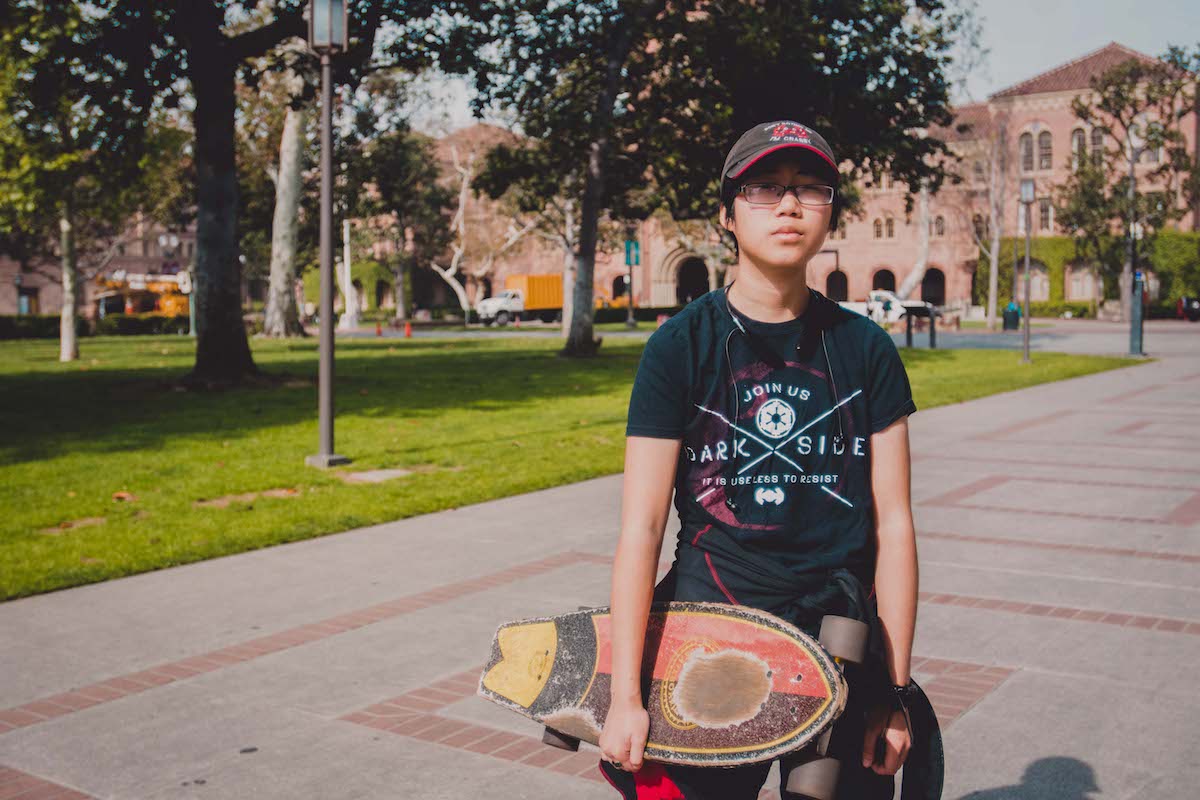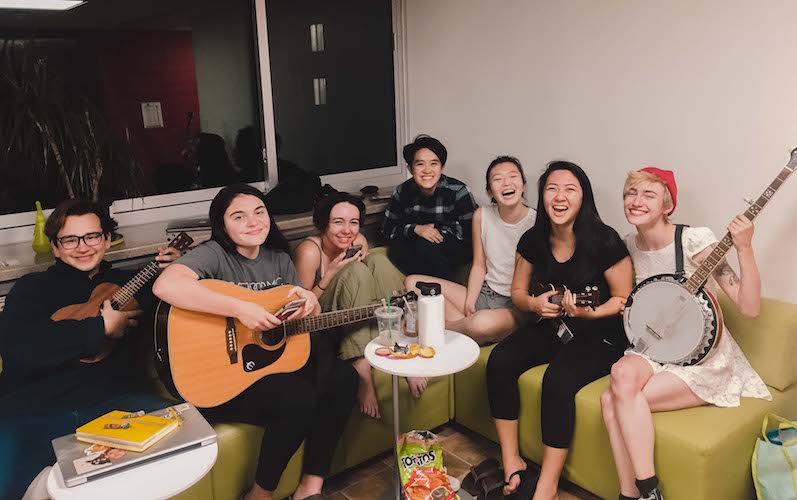Special interest spaces create community
USC Housing currently offers five cultural floors and two gender-inclusive floors.
It plans to create a gender-neutral floor in the USC Village by Fall 2019.
By Eileen Toh, News Assignments Editor

Upon entering the study lounge on the sixth floor of Fluor Tower, residents are greeted by a mural emblazoned with vibrant colors. Overlaid with a blue gradient sky, the mural outlines an Aztec pyramid and a range of mountains traced along the plastered wall. Front and center stands the iconic eagle — with the snake trapped in its beak — from the Mexican flag, perched on a stone pedestal.
The mural was a gift from the residents who lived on the Latino Floor from 1997 to 1998.
Having grown up in a predominantly white neighborhood, junior Geovanna Nichols-Julien found the space welcoming and refreshing in her freshman year. It was a place for her to further explore her Latina identity. Now, she’s the floor’s residential assistant.
“I passed for white most of the time [in my hometown], and what the Latino Floor [provided was] a space where I could really understand in myself what it meant for me to be Latina, identify as Latina and be OK with identifying as Latina, even though other people don’t perceive me that way,” said Nichols-Julien, who is majoring in vocal arts.
For years, USC Housing has provided students with several kinds of residential living spaces. According to Emily Sandoval, the senior director of residential education, special interest communities on campus are split into two categories: theme floors and cultural floors.

Geovanna Nichols-Julien first lived on the Latino floor her freshman year. Now as a junior, she returned to serve as its residential assistant and connect with other Latino students
Theme floors host a wide range of communities. Pardee Tower houses students who plan to pursue careers in business, and Marks Tower brings together students in a floor tailored to GO!, or the Great Outdoors. Apart from these two groups are gender-inclusive floors, which provide spaces for students who wish to live together regardless of gender identity or biological sex.
According to Sandoval, cultural floors, like the one Nichols-Julien lives on, were established in part due to student requests, but also to assist with retention efforts at the University.
Nichols-Julien said the floor has aided in her self-discovery, an experience she says wouldn’t have happened if she weren’t directly surrounded by a Latino community. She found it only fitting to give back and help first-year residents reap the benefits of cultural housing, just as she had.
“It made me feel like I had a place to come home to, like a place where people knew my name, knew what I was doing and knew I was stressed,” Nichols-Julien said. “I think what’s incredible about the Latino Floor and cultural interest housing is that [they benefit] all of us who live there.”
The Latino Floor, also known as El Sol y La Luna, was first established in Fall 1974. It remains one of the oldest special interest communities on campus, along with Somerville, a floor that aims “to foster an understanding of and respect for Black culture,” according to its website.
Other cultural floors include the Muslim Floor, the Shalom Floor and the newly established Asian, Pacific Islander and Desi American Leadership Floor. Since these special interest communities were established, Sandoval said USC’s research has shown that the floors help students feel connected to the University and succeed academically.

Colin Chao found a supportive environment living on the Rainbow Floor in Century Apartments. (Emily Smith/Daily Trojan)
“At many predominantly white institutions, including USC, these special interest communities are created to assist students of color with transitioning into campus in a supportive environment of peers that share similar cultural backgrounds,” Rosalind Conerly, director of the Center for Black Cultural and Student Affairs, said in an email to the Daily Trojan. “Since our Black [and] African American undergraduate community is small, this floor creates an opportunity for students to meet one another and to explore their identity.”
Nichols-Julien said the support within cultural interest housing can be attributed to the floor’s connections with USC’s on-campus cultural centers. For example, the Latino Floor works closely with El Centro Chicano to host events for its residents.
Over the last 40 years, the Latino Floor has adopted traditions with its residents in collaboration with the centers. For example, the floor coordinates College Access Day, during which students from local schools can tour the floor. The floor also hosts celebrations for holidays like El Día de Los Muertos, and near Christmas, the floor puts on a nativity play called La Posada.
For spaces that are classified gender-neutral or gender-inclusive, residents — especially LGBTQ individuals — can also live in a more supportive environment. According to the USC LGBT Resource Center website, housing options that match roommates strictly based on biological sex can foster an unwelcoming environment.
Queer and Ally Student Assembly advocacy team intern Colin Chao, who identifies as a transgender man, said these housing opportunities can help students ease into college life. Chao lives on the Rainbow Floor in Century Apartments. The floor has been providing support for LGBTQ students since 2001.
Chao said that he felt “super weary to start with just existing on campus,” recounting moments such as going into male bathrooms, where people would seem to question his gender identity. However, finding out that his roommates were East Asian and gender queer eased some of his worries during freshman year.
“It’s like trying to navigate that distinction, always figuring out: ‘Am I OK?’” Chao said. “But when I’m on the Rainbow Floor with people who have generally been dealing with that question for most of their lives, it feels less likely that I’d be feeling in danger in that community.”

Students living in gender-neutral housing at Birnkrant Residential College enjoy watching TV shows together and playing instruments. (Photo courtesy of Uluwehi Baldemor)
In Fall 2015, gender-neutral housing options were offered in three buildings on and off campus, according to Kelby Harrison, director of the LGBT Resource Center. She also said that the Rainbow Floor divided bedrooms by legal sex.
“This did not serve the needs of our trans student community,” she said in an email to the Daily Trojan.
This academic year marks the first time gender-neutral housing was offered exclusively to first-year students on campus in Birnkrant Residential College. The floor housed nine students in the fall semester, with spring admits moving into the leftover rooms this semester.
According to residential assistant Uluwehi Baldemor, a sophomore majoring in linguistics, out of the 12 spring-admit residents, only two live in a room that is considered gender-neutral.
Nevertheless, Baldemor said many of the residents identify as non-binary, which gives them exposure to people who may share similar experiences.
“The atmosphere I’ve tried to create here is very welcoming and accepting,” Baldemor said. “Everyone pretty much respects each other. There is a lot of support.”
One of the residents, Alexander Polt-Gifford, a freshman majoring in law, history and culture who identifies as a transgender man, said students have quickly established traditions on the floor, such as watching television shows like Baggage or playing musical instruments.
“I feel like that makes it easier for me to connect with my floor because I’m not being scrutinized,” he said. “I feel like we’ve been able to bond with each other a lot.”
According to Sandoval, USC Housing will discontinue on-campus gender-neutral housing for the 2018-19 year, as the floor in Birnkrant was not filled to capacity during the fall semester this academic year. Instead, Sandoval said the housing option will be offered to freshmen in the Cardinal Gardens Apartments.
“There are plans right now to expand gender-neutral housing to all undergraduate apartments, including USC Village,” Sandoval said in an email to the Daily Trojan.
Natalie Lee, a freshman majoring in music industry, said she hopes USC Housing better advertises gender-neutral housing so more residents who want the option can fill allotted spaces. With spring admits taking the empty rooms this semester, Lee said, “It does feel a bit different because not everyone is queer-identifying, or they don’t really understand.”